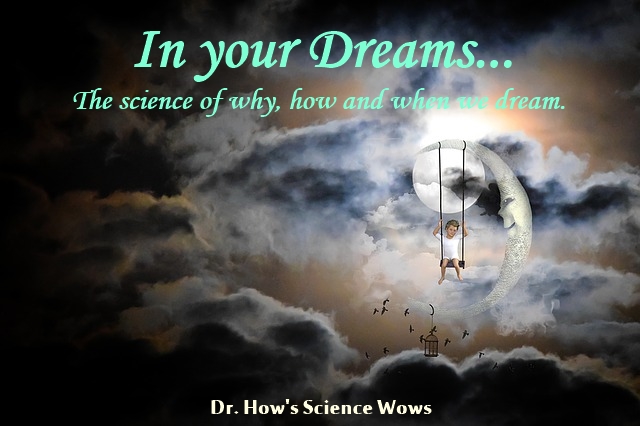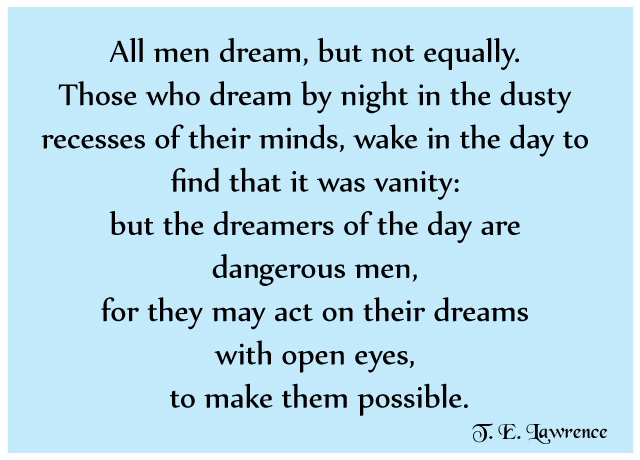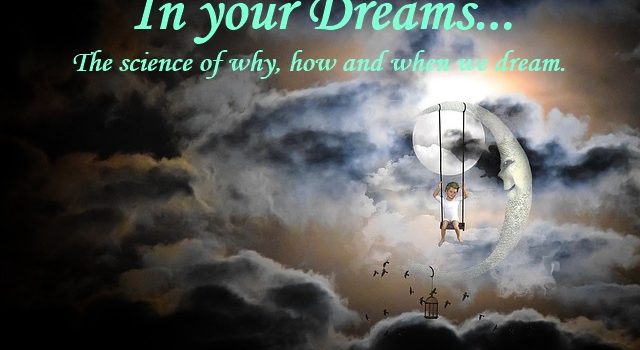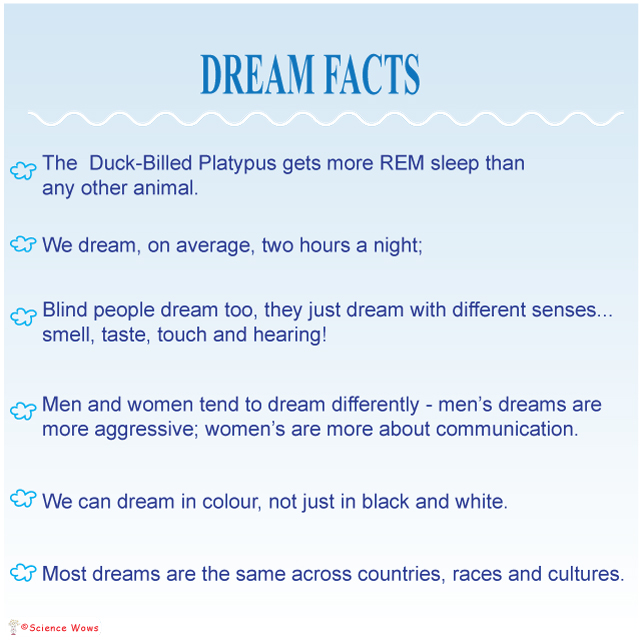Dreams, we all have them, some we remember, some we don’t! There are those who want to analyse every detail of their dreams, seeing them as portents to future events or windows into our souls. Some dismiss dreams as a nothing more than random images as a byproduct of brain activity.
Regardless of what camp of dream analysis you belong to, you may like to know a bit more about the why, how and when of dreams, to fill in the blanks and give a better understanding of what happens when we close our eyes at night.

Are there different types of dreams?
Dreams are a series of images, emotions, senses or events that we experience while we sleep. They are created in the brain, during different brain impulses and can last from a few seconds, to more than half an hour. There are a number of different types of dreams, the classifications vary depending on who you talk to, but in general we experience regular dreams, lucid dreams and nightmares.
The three basic types of dreams are…
- Regular dreams usually occur when we are in a deep sleep phase, such as the REM (Rapid Eye Movement) stage of sleep.
- Lucid dreams usually occur when we are in a lighter stage of sleep. We are at least partially aware that we are dreaming and we can consciously change the course of the dream if we so choose.
- We are all familiar with nightmares and they are not just for children. They are dreams that evoke strong emotions and reactions within us, usually fear, terror, anger or anxiety.
What happens when we dream?
In order to talk about dreaming we must first look at what happens when we sleep and the different stages involved. There are five stages of sleep, stages 1, 2, 3, 4 and the Rapid Eye Movement (REM) stage.
We pass from each stage of sleep sequentially, usually falling into a deeper sleep with each stage. Once we have completed a full cycle (stages 1, 2, 3, 4 and REM) we return to the first stage and the cycle repeats. A full cycle takes between 90 and 110 minutes.
Stage 1
This is a very light stage of sleep, our bodies relax, our muscle activity slows and we experience slow eye movement.
Stage 2
Our eye movements stop, our muscle movements reduce and our brain waves slow down; Our heart rates slow and our body temeratures drop a little. We also experience burst of rapid brain wave activity in this stage, these are called brain spindles. Adults spend about 50% of their sleep time in this stage, this reduces with age.
Stage 3
We enter deep sleep, with some periods of very slow brain waves recorded.
Stage 4
The periods of very slow brain waves extend.
REM Stage
Our eye movement becomes erratic and jerky, our heart rates rise, breathing becomes more rapid and our limbs become temporarily paralysed. We spend about 20-25% of our sleep time in this stage (infants can spend up to 50% of sleep in the REM stage).
The REM stage of the first cycle of sleep is fairly short (about ten minutes) but increases in duration with each cycle (up to an hour in the final cycle).
Stages 1 to 4 of sleep are collectively referred to as the non-REM stages (NREM).
We dream at all stages of sleep but most of our dreams are thought to occur during the REM stage. Studies show that we tend to have different types of dreams at different stages of sleep; In the early stages, we have very short dreams but they are more realistic and relatable. As we move into deeper sleep our dreams tend to become more fragmented. As the night progresses and we experience longer REM states our dreams become more obscure and disjointed.

Why do we dream?
There are a number of theories as to why we dream, but scientists are still not sure. Some say that dreaming is an asinine activity that serves no purpose, but most agree that this is not the case, although they may argue as to the true value of dreams.
Dreaming has no purpose at all
In 1977 psychiatrists J. Allan Hobson and R.W. McCarley theorised that dreams don’t actually mean anything at all. They called their theory the ‘activation-synthesis hypothesis’ and stated that dreams are merely electrical brain impulses that pull random thoughts and imagery from our memories.
Dreaming is an ancient biological defence mechanism
Evolutionary biologists studying dreams and their function have proposed the Threat Simulating Theory (TST) of dreaming.
The threat simulation theory of dreaming states that dream consciousness is essentially an ancient biological defence mechanism, evolutionary selected for its capacity to repeatedly simulate threatening events.
Basically, dreams are seen as a simulation, a way to prepare our bodies and hone our skills for the right response in potentially threatening situations. By experiences threats and events in our mind (like being chased by a wild animal!) we can train our bodies to respond correctly if or when the threat really does appear in real life. We can develop our neuro-cognitive mechanisms.
The TST also suggests that people under threat in their everyday lives will dream more, as a way to exercise and prepare for the dangers they may experience each day. There is some evidence to suggest this is the case.
Scientists in favour of this theory also quote the fact that a convincing 70% of our dreams are made up of such threatening scenarios.
Dreams help us solve problems
It is possible that dreams help us unravel and review all the complexities we have experienced during our waking hours. Without the restrains of our conscious, logical thinking we can view things from a completely different angle. Some people can wake after a night of sleep with their eureka moment, solving a niggling problem, literally while they catch some z’s. Perhaps the most famous case is that of the chemist August Kekule, who supposedly discovered the benzene ring structure after dreaming of atoms linking together in a chain and then twisting, like a snake biting his own tail, into a ring structure.
The famous American writer, John Steinbeck called this the ‘committee of sleep‘…
It is a common experience that a problem difficult at night is resolved in the morning after the committee of sleep has worked on it
How does all this free thinking work? Daytime events and often recorded in fragmented forms in different regions of the brain. The ‘memory’ is held together by interaction of those brain parts with the hippocampus. During certain stages of sleep these connections are lost, but brain activity in each of these regions may continue. This ‘untethered’ brain activity can provide the freedom of thought and creativity that is constrained in the waking hours.
We dream to fulfil our desires
This brings us back to Freud who believed that our dreams were a manifestation of our basic, unconscious desires and urges. He believed that to better understand our own psychological makeup, and issues, we needed to record and analyse the content of our dreams.
We dream to help us process our emotions
Do we dream to help us process emotional events in a safe way? When we sleep the levels of certain stress hormones in our bodies are reduced, therefore we can reflect on a stressful situation or event, in a safe place, where the stress response has been toned down.
Studies have observed high activity in the amygdala during the REM stage of sleep. This is the area of the brain associated with emotions. This suggests that, while sleeping, our brains access emotional events and memories while the stress neurochemicals (norepinephrine) are suppressed, allowing us to process and resolve any emotions or traumas. We wake feeling better about an event that may have caused us stress the day before.
Dreaming is an important part of our memory storing process
The process of dreaming may help us strengthen, connect and store memories. In order to full consolidate our memories we need to strengthen links between different areas of the brain that have recorded information from the memory, and to integrate the information with previously stored knowledge.
The most basic function of dreaming consists of connecting new material with old material in memory systems; reorganising the memory systems, guided by emotion. (Hartmann, 2011).
Sleep creates an optimal environment to allow memory links to be repeatedly activated without the interference of external stimuli. This reactivation strengthens the neurological pathways that link the various parts of the memory as well as creating links with older memories and learning.
MRI studies have shown that brain areas associated with short and long term memory consolidation (hippocampus and amygdala) are activated while we dream.
Different types of memories may be consolidated at different stages of sleep; the episodic memories are best processed during NREM stages, while more sensory, procedural and emotional events are likely integrated during REM stages.
How long do dreams last?
Dream length varies, but on average our dreams start off short and get longer as the night progresses. Although some dreams may only last for seconds, our first dream of the night is usually about five minute long, our last dream can be as long as 45 minutes. As most of our dreaming occurring during the REM stage of sleep, as this stage gets longer, so too do our dreams.
Most people have at least two to three dreams per night, with the average being six to seven. We spend about two hours a night dreaming, which can add up to a whopping six years of dreaming in a lifetime!
These theories and insights are fascinating but there is still much to learn. Scientists will continue to research, study and debate the importance of the dreaming process, but, looking at how much of our lives we spend dreaming it is certainly a worthwhile study.

